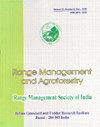Efficacy of biocontrol agents against Sclerospora graminicola causing downy mildew in fodder pearl millet
IF 0.8
4区 农林科学
Q3 AGRONOMY
引用次数: 0
Abstract
Downy mildew incited by Sclerospora graminicola is the main hurdle in the successful cultivation of pearl millet and is capable of causing more than 60% losses in terms of grain and fodder yields. The disease could be managed by fungicide applications but due to several associated environmental and health-related issues, there was a necessity to formulate some eco-friendly measures for downy mildew management. Thus attempts were made to find out the usefulness of three biocontrol agents (Bacillus subtilis, Pseudomonas fluorescens and Trichoderma viride) and two fungicides (mancozeb 64% + metalaxyl 4% and metalaxyl) under field conditions for three seasons (2017-2019) against downy mildew. The least downy mildew incidence (14.37%) was observed with seed treatment + foliar spray of B. subtilis as compared to untreated control (31.30%) with 54.10% disease reduction followed by seed treatment + foliar spray of P. fluorescens (17.58% disease incidence) with 43.82% disease control. The same treatments were significantly superior over others in increasing the green fodder yield by 56.59 and 40.79% respectively. Another treatment proven effective was seed treatment + two foliar sprays of T. viride which provided more than 43% reduction in downy mildew incidence as compared to chemical check which provided 30% disease control and increase in green fodder yield. These findings advocated the potential use of biocontrol agents against downy mildew of pearl millet in an eco-friendly manner.生物防治饲料珍珠粟霜霉病的效果研究
由谷粒核孢菌引起的霜霉病是影响珍珠粟成功栽培的主要障碍,可造成谷物和饲料产量60%以上的损失。霜霉病可以通过使用杀菌剂进行管理,但由于一些相关的环境和健康问题,有必要制定一些环保措施来管理霜霉病。在2017-2019年3个季节的田间条件下,研究了枯草芽孢杆菌、荧光假单胞菌和绿色木霉3种生物防治剂和2种杀菌剂(代森锰锌64% +甲螨灵4%和甲螨灵)对霜霉病的防治效果。种子处理+枯草芽孢杆菌叶面喷雾组霜霉病发病率最低(14.37%),比未处理组(31.30%)发病率降低54.10%;种子处理+荧光假单胞菌叶面喷雾组(17.58%)发病率降低43.82%。相同处理的青饲料产量分别提高56.59%和40.79%,显著优于其他处理。另一种被证明有效的处理是种子处理+两次叶面喷洒绿霉,与化学检查相比,减少了43%以上的霜霉病发病率,化学检查提供了30%的疾病控制和提高绿饲料产量。研究结果表明,利用生物防治剂对珍珠粟霜霉病具有潜在的生态保护作用。
本文章由计算机程序翻译,如有差异,请以英文原文为准。
求助全文
约1分钟内获得全文
求助全文
来源期刊

Range Management and Agroforestry
AGRONOMY-
CiteScore
1.50
自引率
62.50%
发文量
25
审稿时长
>12 weeks
期刊介绍:
The Society has been established with the following objectives:
1. To advance the cause of research activity in all aspects of rangelands and to encourage and promote the studies on rangeland, wasteland ecosystems and agroforestry.
2. To provide facilities for seminars and conferences to rangeland researchers, development workers and farmers and to encourage close cooperation with organizations having related aims and interests.
3. To disseminate the knowledge of scientific agriculture and technology for forage and rangeland production, improvement and management.
 求助内容:
求助内容: 应助结果提醒方式:
应助结果提醒方式:


